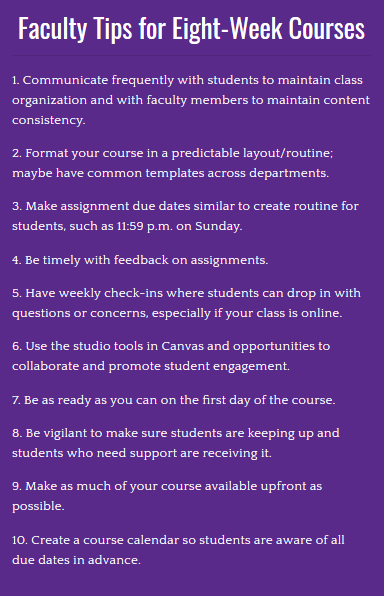July 13, 2020
BLOCK SCHEDULING
by Kristen Martin, ECU News Services
Faculty offer tips for adjusting to 8-week classes
East Carolina University is adopting a block scheduling format for the 2020-21 academic year to aid in returning to on-campus instruction.
Each semester will be divided into two eight-week blocks instead of the typical 15-week semester. The majority of classes will follow the block schedule although there will be a few exceptions.
According to Grant Hayes, ECU’s interim provost, the university chose to move to the block scheduling format in response to the uncertainty of COVID-19 because it will allow the university to be more flexible and nimble in its approach in planning for fall classes and implement the necessary adaptations to keep our students, faculty and staff healthy and safe.
While some universities have used block scheduling on a larger scale, it hasn’t been the norm for most universities or at ECU. However, eight-week courses are not new at ECU. Two programs in the College of Education and College of Nursing are currently using this model.
“When we revised the curriculum around 2012, we conducted focus groups and solicited feedback from the students who were enrolled in the RN to BSN option and prospective students,” said Becky Jordan, director of the RN-BSN program. “The information gathered revealed that the majority of people wanted a curriculum that was delivered online and contained blocked courses.”
Of the eight courses that make up the curriculum, five are blocked. The other three are semester-long due to the content they require, such as research, community health and a capstone course.
Nursing faculty say the blocked course format offers flexibility with students’ schedules and allows the students to take the same amount of semester hours while focusing on no more than two courses at a time.
“The structure and flexibility that this format offers have allowed the students to achieve their academic goals in four semesters,” Jordan said.
In the College of Education, the Master of Arts in Reading and Literacy Education program is an online, 30-semester-hour program that uses the eight-week model to advance educators’ knowledge and competency in K-12 reading and literacy education. According to Dr. Elizabeth Swaggerty, the majority of their graduate students are working full time in the classroom while completing the program.
“We chose the eight-week model because we anticipated that shorter chunks of time to concentrate more deeply on content would benefit this population of students, particularly since they’re working full-time jobs,” said Swaggerty, the graduate coordinator for the Department of Literacy Studies, English Education and History Education.
Swaggerty said this model works for graduate students since they don’t have to juggle multiple courses, course calendars and instructor expectations.
Literacy studies professor Dr. Kim Anderson also emphasized the ability to focus as a perk of the eight-week model, as far as graduate students were concerned.
“What we learned is probably limited in its applicability to all programs, particularly undergraduates, but that being said, the students seem to appreciate the eight-week format,” she said. “I looked at the feedback on the end of course survey and they’ve said, ‘I love that we’re able to focus on one course at a time’ and ‘It’s better than trying to juggle two classes at one time.’”
 Developing Strategies
Developing Strategies
Although both of these programs are graduate-level, nursing and education faculty members developed strategies that can apply to different types of eight-week courses.
Having a predictable course layout, being timely with feedback and providing opportunities to check in with students are crucial in a condensed course, according to Anderson.
“I did weekly Webex meetings that were optional. Each week we would briefly go over what we had done the week before and then set up the next week,” she said. “I would say any given week it was generally around 50-60% of the students who would log in, and they were recorded so students could listen to them afterward.”
She said she thinks the weekly check-ins helped students stay on task and keep up with assignments.
Understanding that you don’t have as much time to introduce the course in a condensed format is also important to remember.
“That’s good advice for instructors, to really be as ready as you can be on day one, because it’s going to start fast and be over before you know it,” Anderson said. “Students don’t have time to lose either. So I think it requires a little more vigilance on the instructor’s part to be sure that everybody’s keeping up and students who need support are getting it.”
Anderson did warn about trying to use too many of the tools in Canvas at one time.
“Every time students have to learn a new tool, that takes time away from learning a course,” she said. “Within a department, I would say maybe discuss with other faculty what tools you are using, so students get more practice with new tools.”
The studio tools Canvas offers and the opportunities to collaborate can be helpful in an online course.
“I would say I did a little bit more group work than I typically do in an online course and I think that really helped, especially right in the beginning. When you teach your regular course, one of the things you always want to think about is community building and helping students feel like they’re part of a community, learning together.”
Faculty members who are interested in group activities may want to utilize flipped learning.
“Flipped learning is based on interactive group learning. Lecturing as a method to disseminate information was a necessity in the age when books were scarce and not everyone could read,” said Dr. William Swart, a professor of marketing and supply chain management in the College of Business. Today, information traditionally delivered in lectures can be made available through Canvas in multimedia formats so that students can access it at their convenience, at a location of their choice, in a format that best supports their learning. This frees up classroom time to engage students in collaborative activities to reinforce what they learned outside of class under the guidance of their instructor.”
Swart’s research has shown that flipped learning results in increased student satisfaction, better learning and increased retention in face-to-face and online classes.
“There is no reason why it cannot yield the same benefits in ECU’s blocked scheduling plan,” he said. “Blocked classes meet for longer periods of time and present a greater challenge to student engagement. Active and collaborative learning have demonstrated that they keep students more engaged compared to lectures.”
However, he cautioned that flipped learning isn’t a quick fix since there is no one way to flip a class and instructors have to evaluate their methods throughout a few semesters.
“It requires rethinking of everything: out-of-class materials, in-class learning materials, learning spaces, the role of the student, the role of the instructor, selection of appropriate technologies and how to organize collaboration,” he said.
“Frequent communication with the students regarding questions and clarification of assignments or course expectations is necessary to maintain the class organization,” Jordan said. “Frequent communication among faculty in the various courses has been valuable in maintaining the consistency of content.”
The faculty try to make assignment due dates similar to set routines that students can follow easily, such as making weekly assignments due at 11:59 p.m. on Sunday.
Making as much information available at the beginning of the course is important when working in a shorter time frame. This can be done by making a course calendar available showing all of the dates for quizzes, tests, discussion boards and other course assignments.
“This allows students to note due dates for assignments so that they can coordinate with their schedules and other obligations thus alleviating some stress for students in knowing what is expected and when,” Jordan said.
Implementing an eight-week course model across most of the university will be a challenging process, but Anderson is hopeful about the outcome.
“University-wide, it will give us some flexibility,” she said. “We have good people at ECU that will make it work, and I do think everybody always has the students’ interest at heart.”
- Categories:
- Academic

